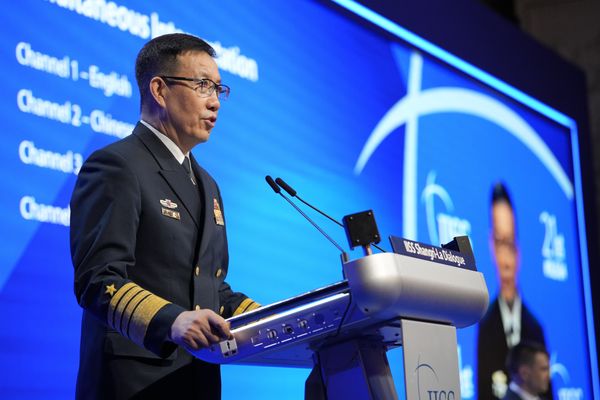General Motors Co.’s controversial decision to ditch two popular phone projection systems from its future electric vehicles could be risky, but the company insists the move will pay off by giving consumers a more vehicle-embedded infotainment experience.
The Detroit automaker's plans to shift away from Apple CarPlay and Android Auto came as a surprise when it was announced in late March. Still, it’s also no secret that automakers want to reclaim territory ceded to tech companies for years and see their own infotainment systems integrated into new vehicles — in part to harvest data from their customers.
Nixing familiar systems in favor of its own, made in partnership with Google, puts GM in a similar bucket as Tesla Inc., which has never offered phone projection but leads electric vehicle sales. GM, however, might be taking a more challenging plunge by removing the systems from upcoming models like the Chevrolet Blazer EV after offering them on its current cars and trucks.
Still, other automakers are likely to follow GM as the industry moves toward more tech-heavy vehicles with electric motors, predicted Sam Abuelsamid, a principal research analyst at Guidehouse Insights. He doesn't think GM's switch will drive many customers away.
“It's probably going to have little or no impact on sales,” Abuelsamid said. “And when other automakers see that it has relatively little impact, they're eventually going to go down the same path. Because the arguments that GM makes for doing this apply to everybody. Everybody wants to control the user experience and have a distinct user experience for their vehicles.”
Still, given the rocky history of automaker-backed infotainment systems, Abuelsamid said, “they probably should have continued … to include the projection systems on those vehicles and say, ‘look, if you use the built-in system, you're going to have a better experience.'"
GM’s rationale
GM confirmed at the end of March that it would transition away from the phone projection systems and instead would have an infotainment system developed with Google that will be integrated with applications such as Google Maps, Google Assistant, Audible, Spotify and others.
Apple users are more likely to take issue with the change since Apple-based apps, like Apple Music and Apple Podcasts, are not available to download on GM's new system. But consumers can still use Bluetooth to access their music, shows, hands-free calling and hands-free voice texting.
The decision to remove CarPlay and Android Auto only affects EVs. At this time, GM’s internal combustion engine products will have access to both phone projection and the new Google built-in system.
The new system will be available first on the 2024 Chevrolet Blazer EV and later on other select EVs, including the 2024 Chevrolet Equinox EV, 2024 Cadillac Celestiq and the 2025 GMC Sierra EV.
The new system will help customers with EV routing based on real-time data. It can show drivers the vehicle's state of charge, locate charging stations and share their availability. The system also can create navigation routes to use driver assistance technologies like GM's Super Cruise.
“It's a great opportunity for us to really present how important our digital experience is to our future,” said Nick Festa, GM’s director of digital business. “The key integrations are really important to how customers are going to experience the value of the system moving forward. We're confident. Hopefully, as our customers begin to experience these things, they will grow just as confident.”
The system could give GM a chance to capture more data on how consumers drive and charge EVs.
"I would say it's not about data per se, it's about understanding," Festa said. "As we are trying to ramp up for vehicle capabilities like EV and energy management, like hands-free driving, like over-the-air software updates that we want to provide to our customers, having that understanding helps us make a better product."
"Better product means more engagement and greater satisfaction with our vehicles," he said. "And so I would say that that's core to it as well, for sure."
CarPlay “played a very important role because customers were seeking better navigation, better voice, better solutions and so people have absolutely become confident with that solution as being preferred,” Festa said. “I think that those problems can get solved with embedded solutions better, and we have some credibility to demonstrate.”
GM's system has a “purpose-built nature” that “goes deeper” into features customers may not have experienced yet because they haven't driven an EV or used GM’s hands-free SuperCruise driving technology.
“Once customers begin to experience those products as we come up the adoption curve, they'll start to realize that those are also critically important solutions for them in their driving experience that go above and beyond making a phone call or a text message or streaming a podcast,” Festa said.
There are a few reasons that GM decided not to make both the phone projection and Google built-in systems available together on future EVs. It’s partly the resources it takes to offer both but also the consumer experience with having both options.
“Customers will find themselves in situations where they're bouncing back and forth in between different ecosystems for whatever job they're seeking to accomplish,” Festa said.
GM wants the operation to be seamless for customers. Like other automakers, GM is pushing to be known more for its technology offerings and to collect revenue from subscription services. While this system may help pull in revenue at some point, Festa said, “I wouldn't anchor on the idea that this is about subscriptions. That's not what this is. This is an opportunity for us on a go-forward basis to make the digital experience of our vehicles just as important and differentiated for our customers.”
The Blazer will come with standard connectivity that allows customers to access Google Maps and Google Assistant, at no additional cost, for eight years starting from the date of purchase.
The timing for the change away from phone projection comes as GM adds more EVs to its portfolio and scales its software platform. Creating an infotainment system is just one part of GM's mission. It's also working on the new Ultifi software platform, which enables ongoing innovation from GM and third-party collaborators.
And late last month, the automaker announced it had shared its own software industry standard called “uProtocol" with the community. The standard "aims to speed up software development by streamlining the creation of software that is distributed across multiple devices within vehicles as well as across the cloud and mobile," GM said. It could connect automotive applications and services in all products — not just in GM's models and not just for vehicles.
GM also announced it joined the Eclipse Foundation, an open source software foundation. The automaker introduced uProtocol at a recent Eclipse Foundation event in Portugal.
uProtocol is not owned or trademarked by GM. It's meant to be "a call to action for other companies to rally around a set of technologies that can be collaboratively deployed," the automaker said.
What other automakers say
Edmunds.com Inc.'s website allows consumers reviewing vehicle inventory to select and filter for vehicles that have Apple CarPlay or Android Auto and found “that nearly half of consumers putting connectivity on their must-have list will be concerned about those functions from Apple and Android,” said Ivan Drury, director of insights for the vehicle information website.
“I'm certain that other OEMs, they are glad to let GM go into this,” he said. “They're gonna see this as the benchmark for is it feasible.”
In AutoPacific's 2022 Future Attribute Demand Study, surveying more than 10,000 new vehicle intenders (those planning to get a vehicle in the next three years), the automotive research and insight firm found wireless Apple CarPlay and Android Auto were the second-most demanded infotainment and connected technology feature.
Matt Beard, 38, of Houston, drives a 2015 Nissan Murano that doesn’t have CarPlay, but since he’s experienced the system in rental cars, he wants it in his next vehicle. He was interested in the electric Blazer and then he heard about GM’s decision to cancel the system on the new SUV coming out later this year.
“I don’t want another system that’s going to be out of date after a year,” he said. “I like the fact that it’s an extension of my phone.”
Historically, consumers have rejected other OEM infotainment systems that didn’t work well.
“It's becoming less of an issue, but in the past, most of them were pretty bad,” Abuelsamid said. “They were underpowered, they didn't have the same functionality you could get with the projection systems. You had a limited number of apps that were available. The performance was bad. They were unstable. They crashed. There were all kinds of issues with these systems.”
Beard, the Nissan Murano owner, said his next vehicle “definitely” will have CarPlay unless GM’s system turns out to be superior. “But I don't see how it would be considering (with CarPlay), it's just an extension of my phone … I don't see how it would be an improvement,” he said.
While GM is taking the risk to go on without phone projection systems, other automakers are sticking with them. Ford Motor Co. will continue to offer Apple CarPlay and Android Auto in its vehicles, the company confirmed.
The automaker is doing so “because customers love the capability that enables easy access and control of their smartphone apps — especially our EV customers because some EVs currently do not offer the features,” Ford spokesperson Alan Hall said in a statement. Hall pointed to customer data, both collected by Ford and third parties, that indicates customers want the features in their vehicles.
Most recently, Ford’s luxury Lincoln brand introduced an all-new version of its Nautilus SUV. The redesigned mid-size vehicle features a next-gen digital interface and connectivity system that includes Apple CarPlay. Stellantis NV, which offers Apple CarPlay and Android Auto, declined to comment on its plans.
Hyundai Motor Co. has no plans to stop offering Apple CarPlay and Android Auto on its vehicles, including EVs, spokesperson Michele Tinson said.
In a statement, Toyota Motor Corp. spokesperson Curt McAllister said the company “is committed to offering customers a choice for their in-car connectivity.”
The Japanese brand’s latest multimedia system, available in many 2023 Toyota and Lexus models, features wireless integration of Apple CarPlay and Android Auto, and other models continue to feature Apple CarPlay and Android Auto compatibility.
Honda Motor Co. works with Apple, Google and Amazon, spokesperson Lynn Seely said in a statement.
“Our customers find value in our support of CarPlay, Android Auto and Google built-in, and we now offer these connected solutions across our lineup,” Seely said. “We will continue to offer a range of high quality, interactive solutions to provide value to our customers that match their own technology choices.”
(Detroit News Staff Writers Jordyn Grzelewski and Breana Noble contributed.)







